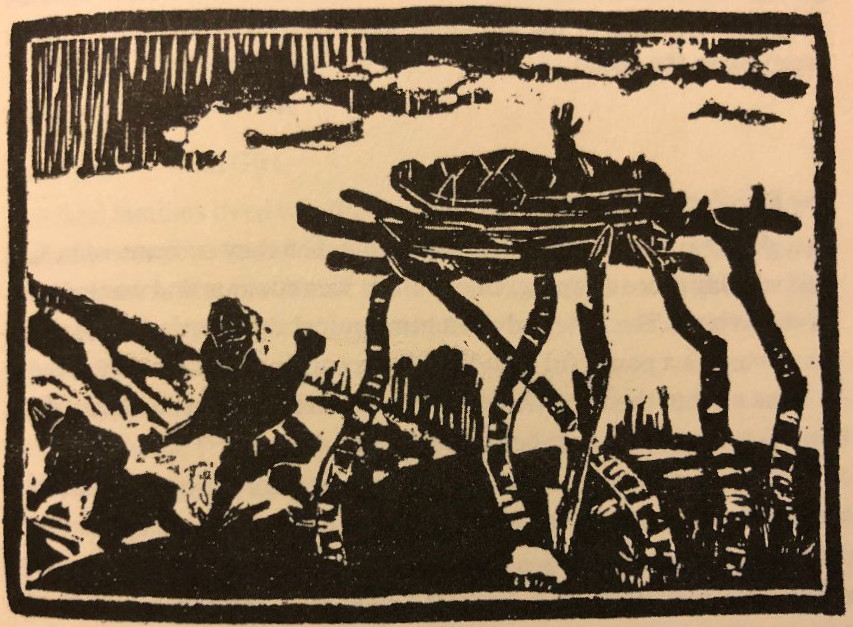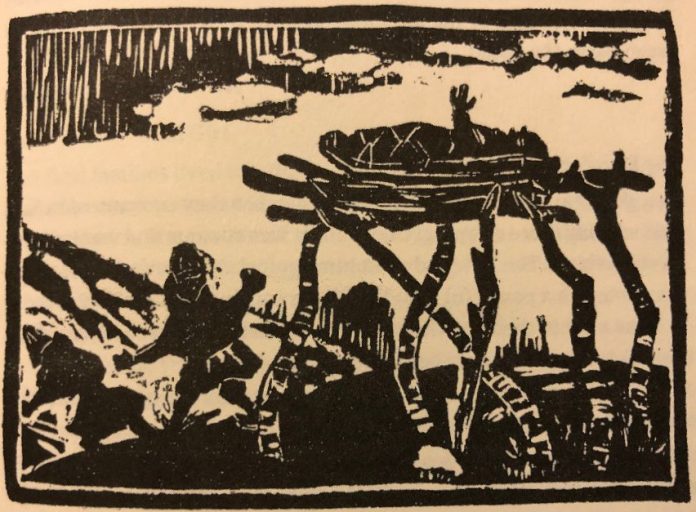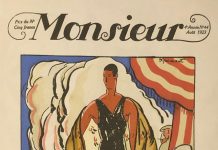Each Halloween I review a book that seems to set the mood for the most important day of the year. By the Fire is not a book about Halloween, but this collection of folk tales from the far north of Sweden certainly sets the mood.
This is the first English translation of a book published in Sweden in 1922. It is based on folktales told by the Sami people of north Sweden that were collected by Demant Hatt and her husband Gudmund in their travels to that remote region back in 1910-1916.
Most of the tales related here are quite short, with typically two on a single page, although a few stretch a bit longer. It is divided into different general categories of folk tales, including one on animals and another on sickness spirits.
The first section is about wizardy, and the figure shown here comes from a tale in that section entitled The Sami Man who wanted his dead wife back. When she died he wrapped her up in a sled and placed it on a high platform supported by poles, but he kept her arms and legs free. He went to sleep but told two young herders to wake him up when she lifted one hand in the air. Neither herder woke his master when this happened.
“After a little more time has passed, the corpse lifted herself halfway up, but since she was bound fast and hadn’t been untied yet, she had to remain where she was. The two young herders were actually smarter than they appeared. They suspected that if they untied her, one of them would have to go in her stead.”
The tale then switches to a phantasmagoric dream the husband has, where he travels to the spirit kingdom. There he sees his wife about to be married to a ghost. I won’t spoil how the story ends, but it’s certainly a creepy tale worthy of a Halloween story. Another tale in the book about the dead coming back to life is in a section entitled Murdered Children, which I will let you read if you are brave enough.
If the tales are to believed, the Sami were a persecuted people centuries ago. They were attacked not only by people from Russian, called Chudes, but from Finns as well. The king of Sweden, who lived in the south, had been led to believe the Sami were not even human, so they got no protection. However a merchant who was sympathetic to the Sami took a Sami man in a packing case to the king. “The king said then that the Sami were people like other people, and he arranged for laws to be made so that no one had permission to kill them.” This idea of good justice coming from the king is evident in other folktales related here.
Complete with field notes and an afterword that sets the folktales in context and helps explain them, this is a very fine book. If you are sitting around a fire this Halloween, or just near a fireplace, reading a few of these tales out loud will send a chill down the spine. You might have to get closer to the fire!
By the Fire is translated by Barbara Sjoholm and is available from Univ. of Minnesota Press for $22.95. It contains many evocative woodcut illustrations that appeared in the original.














